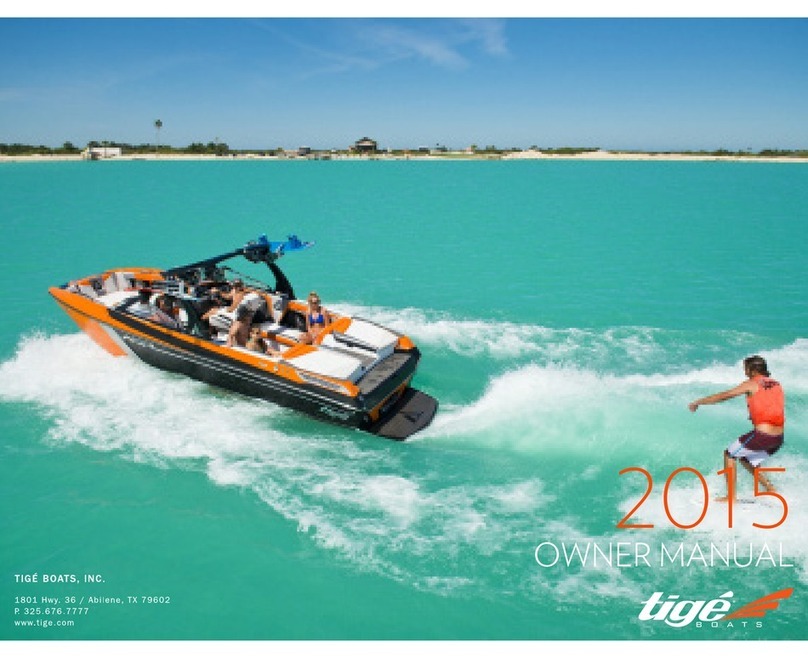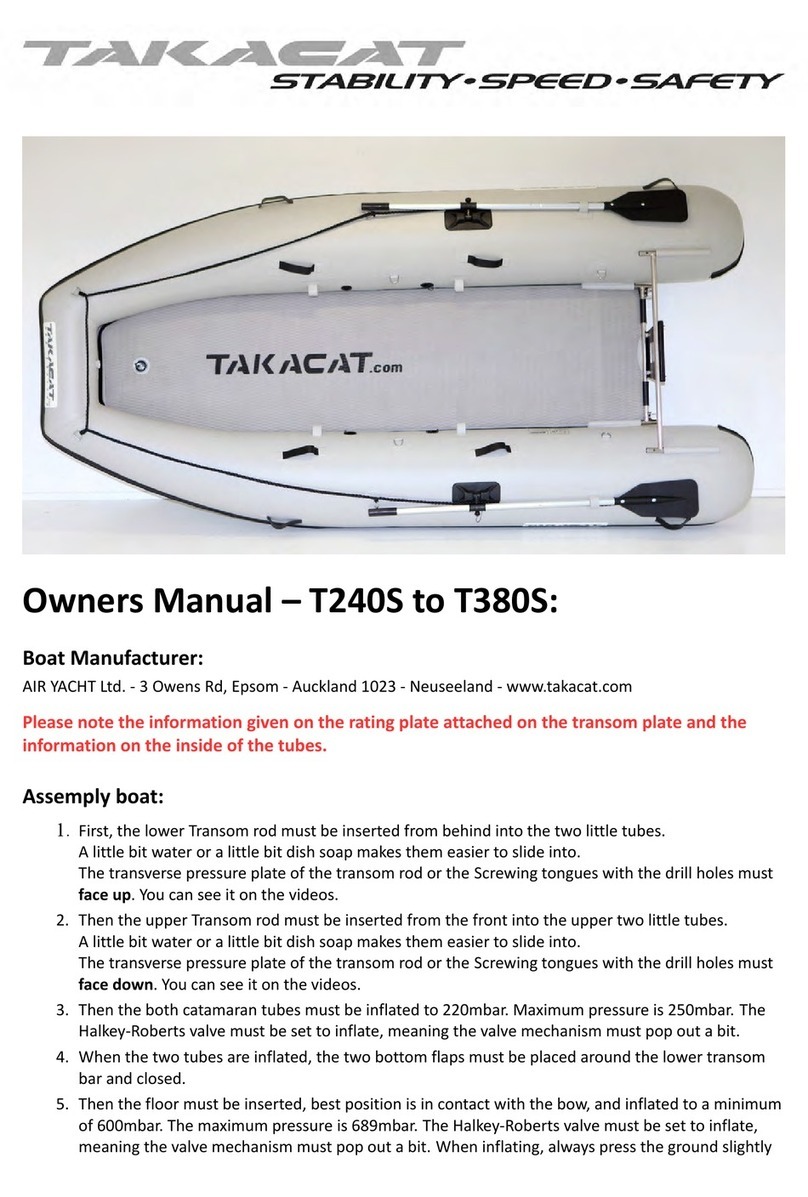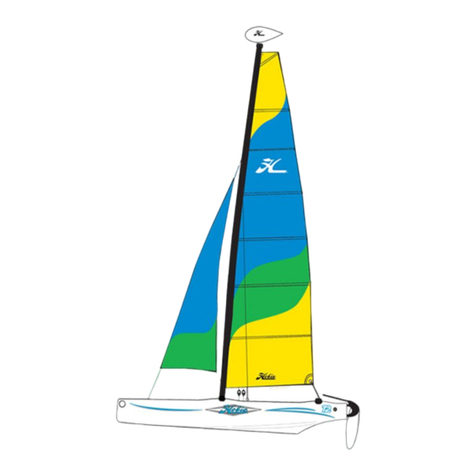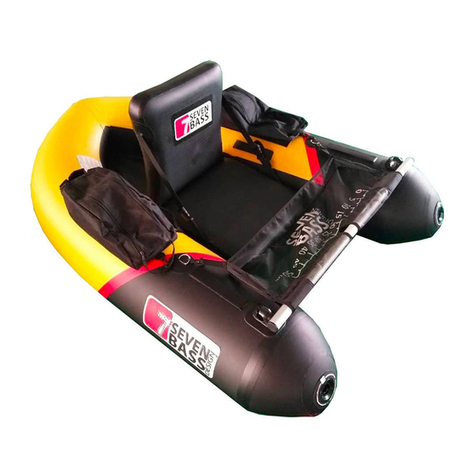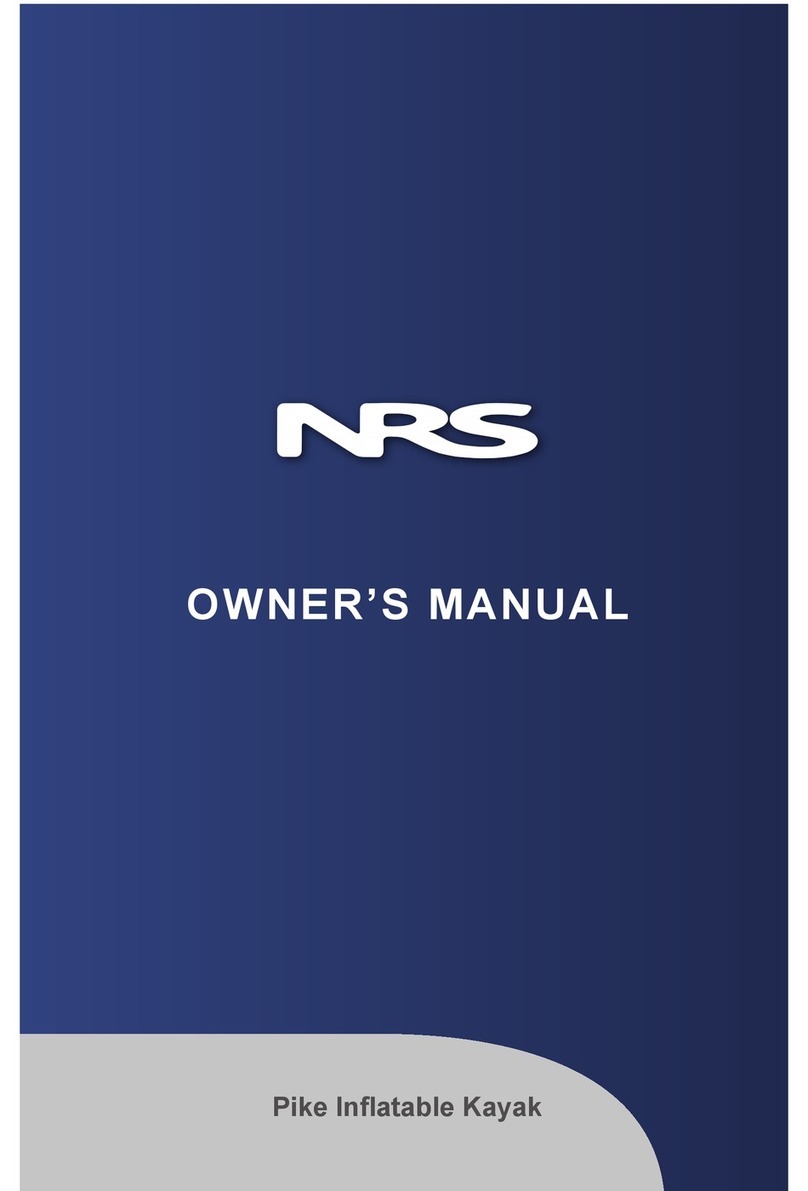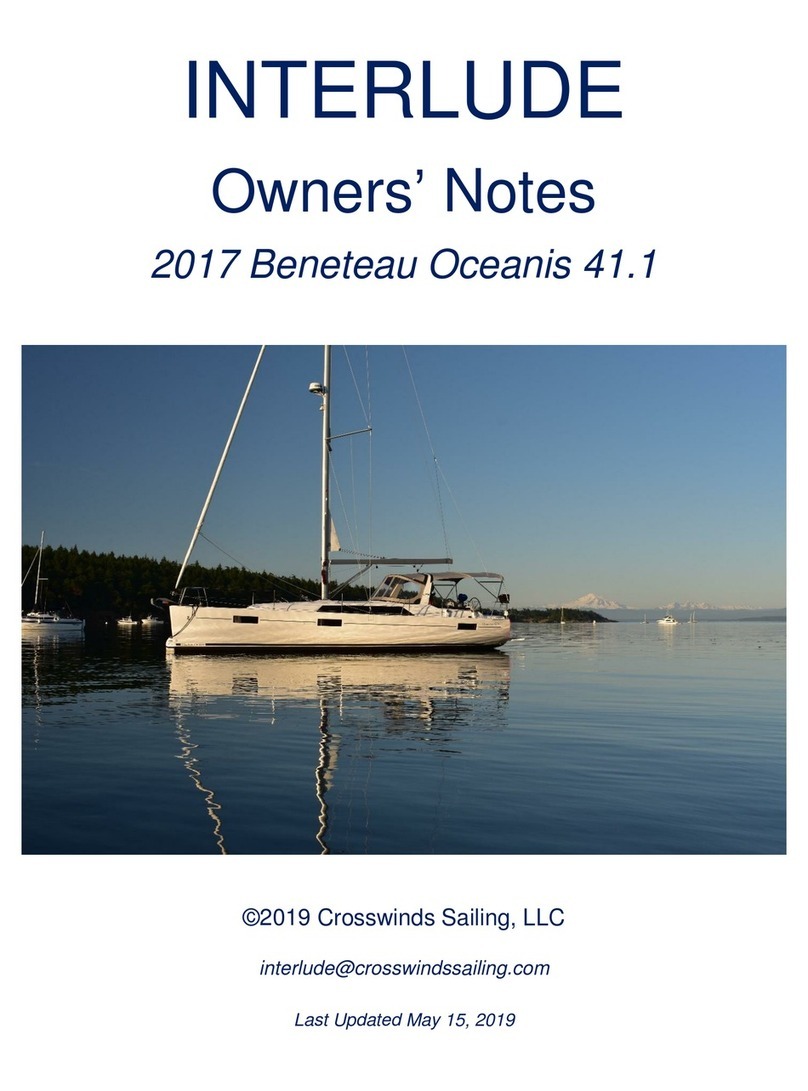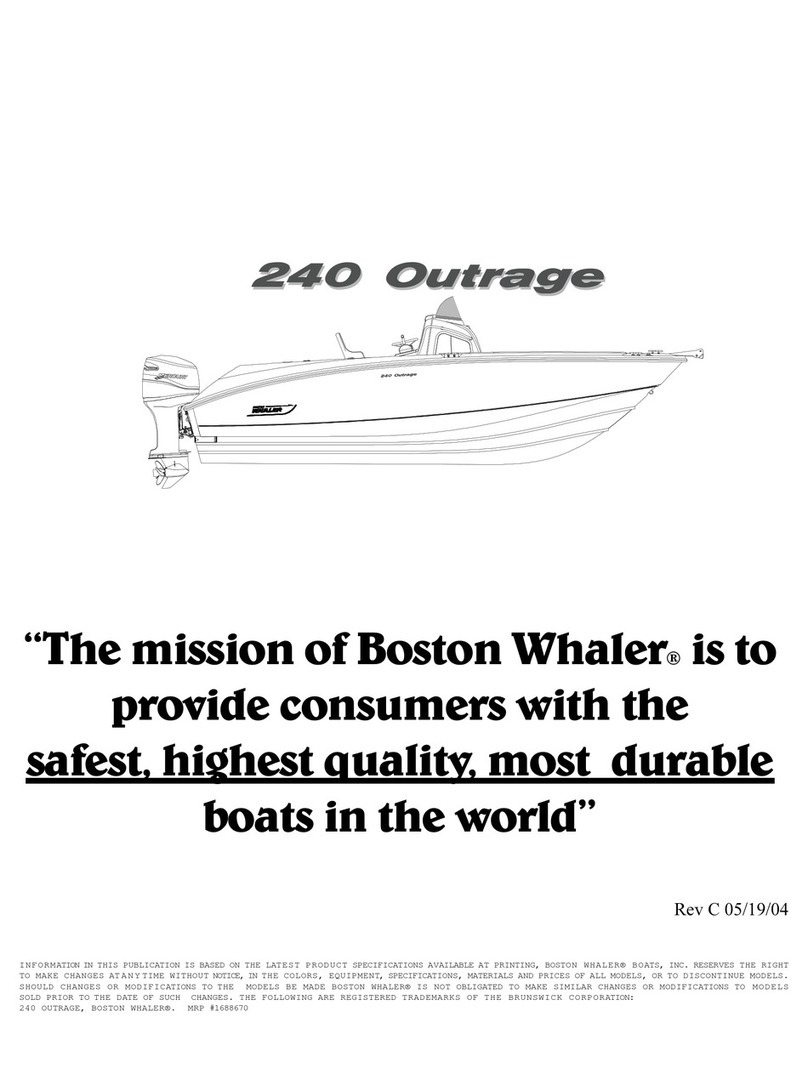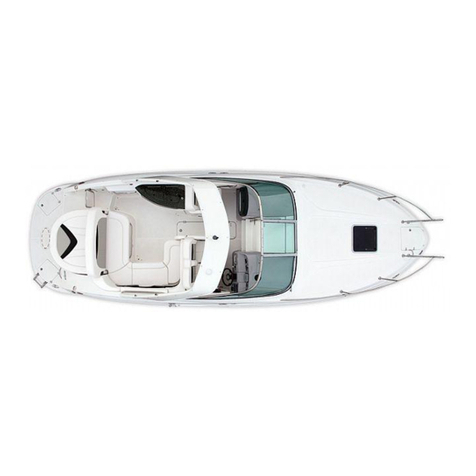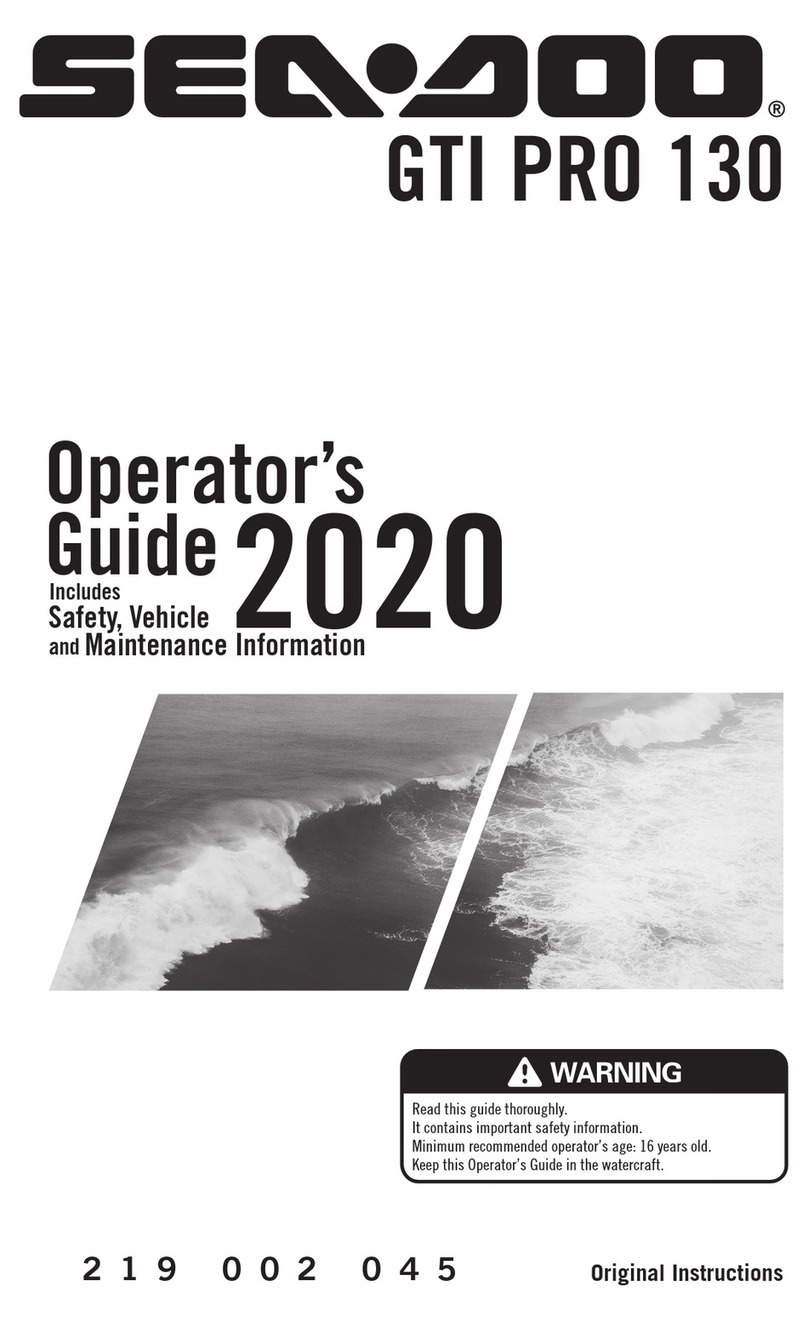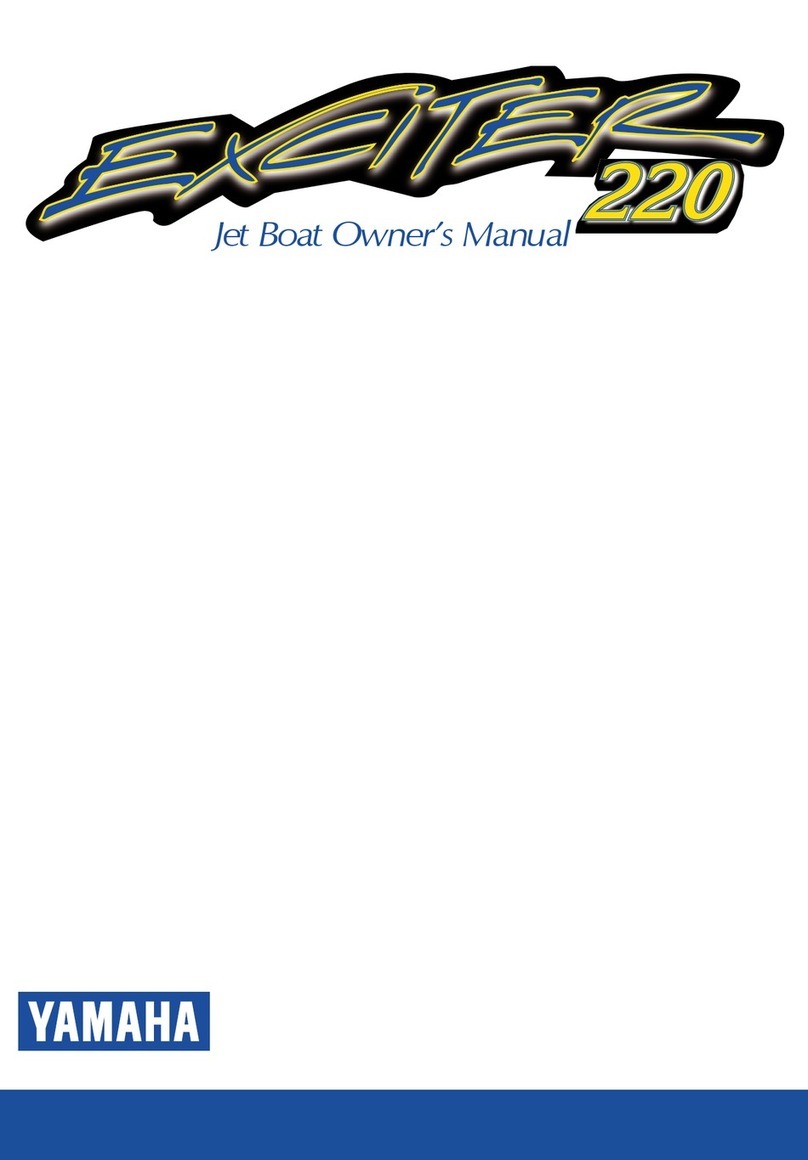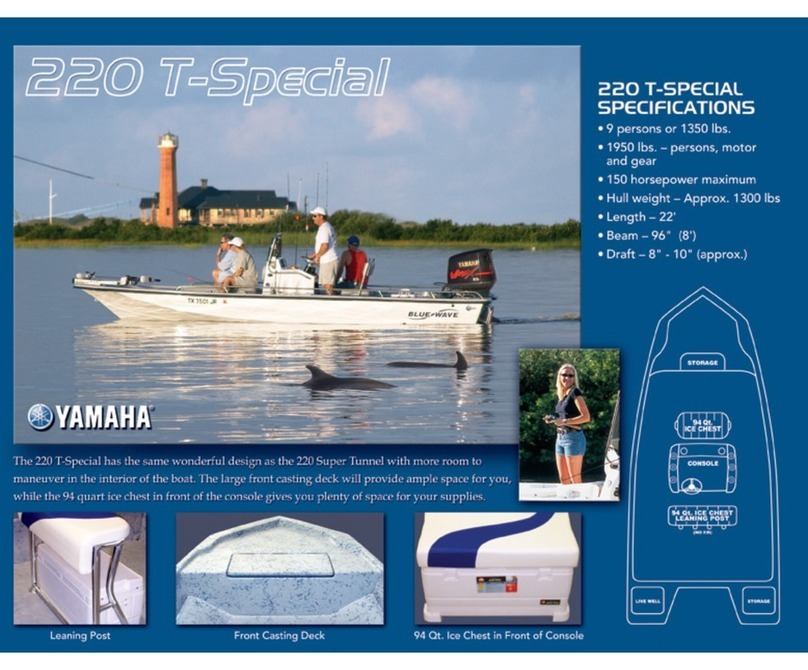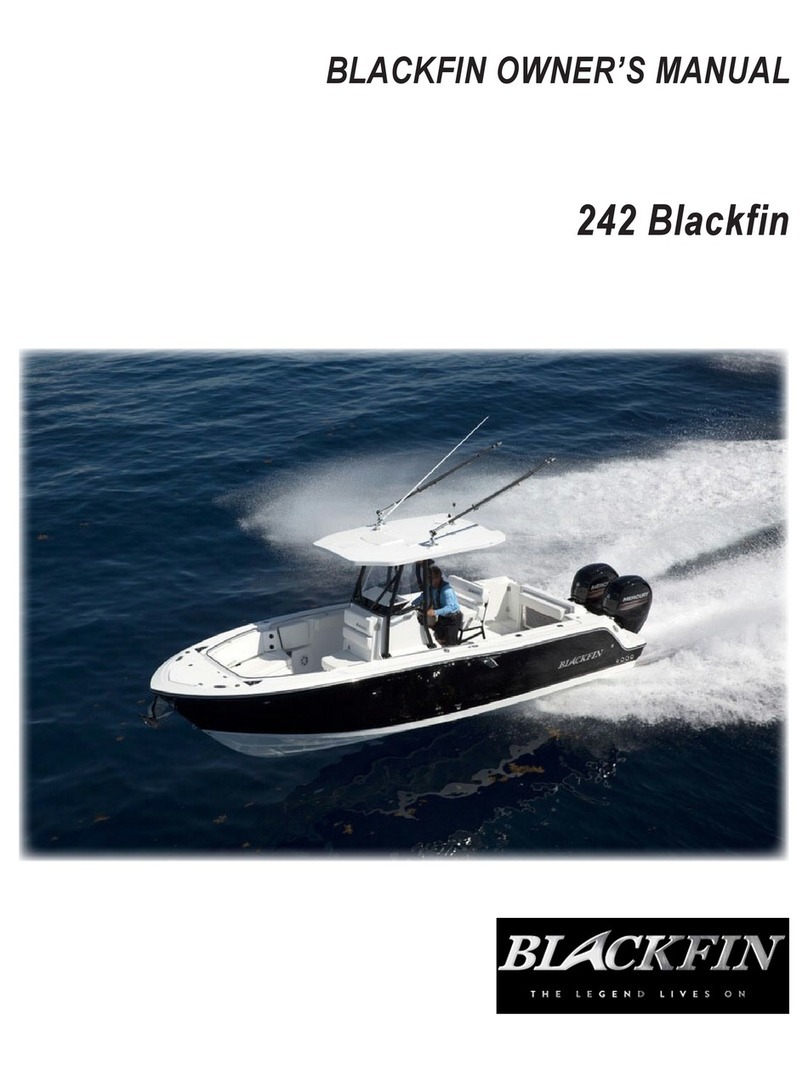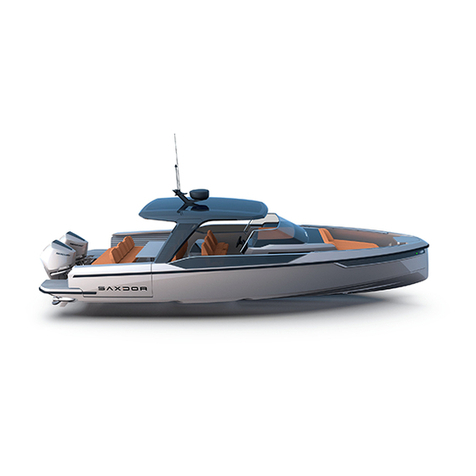Tige Multi-sport Inboard Boat User manual

i
Table of Contents
INTRODUCTION . . . . . . . . . . . . . . . . . . . . . . . . . . . . . . . . . . . . . . . . . . . . . . .1-1
Play It Safe and Enjoy! . . . . . . . . . . . . . . . . . . . . . . . . . . . . . . . . .1-1
Tigé Tips for a Safe, Fun Day on the Water! . . . . . . . . . . . . . . . . . .1-2
Owner's Kit . . . . . . . . . . . . . . . . . . . . . . . . . . . . . . . . . . . . . . . . . .1-2
Intended Use . . . . . . . . . . . . . . . . . . . . . . . . . . . . . . . . . . . . . . . .1-3
Owner Responsibility for Warranty Procedure . . . . . . . . . . . . . . . . . .1-4
Certifications . . . . . . . . . . . . . . . . . . . . . . . . . . . . . . . . . . . . . . . .1-5
Features and Technology . . . . . . . . . . . . . . . . . . . . . . . . . . . . . . . .1-6
Serial Number Locations . . . . . . . . . . . . . . . . . . . . . . . . . . . . . . . .1-8
Owner/Operator Responsibilities . . . . . . . . . . . . . . . . . . . . . . . . . . .1-9
Qualified Boat Operators . . . . . . . . . . . . . . . . . . . . . . . . . . . . . . .1-11
Education Opportunities . . . . . . . . . . . . . . . . . . . . . . . . . . . . . . .1-11
Federal, State and Local Regulations . . . . . . . . . . . . . . . . . . . . . .1-12
Reporting Accidents . . . . . . . . . . . . . . . . . . . . . . . . . . . . . . . . . .1-12
Rendering Assistance . . . . . . . . . . . . . . . . . . . . . . . . . . . . . . . . .1-12
Our Environment . . . . . . . . . . . . . . . . . . . . . . . . . . . . . . . . . . . . .1-13
Warning Labels . . . . . . . . . . . . . . . . . . . . . . . . . . . . . . . . . . . . . .1-15
Restricted Areas . . . . . . . . . . . . . . . . . . . . . . . . . . . . . . . . . . . . .1-16
California Proposition 65 . . . . . . . . . . . . . . . . . . . . . . . . . . . . . . .1-16
Emission Control Warranty Information . . . . . . . . . . . . . . . . . . . . .1-16
Boating Terminology . . . . . . . . . . . . . . . . . . . . . . . . . . . . . . . . . .1-17
Specifications . . . . . . . . . . . . . . . . . . . . . . . . . . . . . . . . . . . . . . .1-18
Warranty . . . . . . . . . . . . . . . . . . . . . . . . . . . . . . . . . . . . . . . . . . .1-19
SAFETY . . . . . . . . . . . . . . . . . . . . . . . . . . . . . . . . . . . . . . . . . . . . . . . . . . . . .2-1
Safety While Boating . . . . . . . . . . . . . . . . . . . . . . . . . . . . . . . . . . .2-1
General Precautions . . . . . . . . . . . . . . . . . . . . . . . . . . . . . . . . . . .2-3
Signal Words/Definitions . . . . . . . . . . . . . . . . . . . . . . . . . . . . . . . .2-4
Required Safety Equipment . . . . . . . . . . . . . . . . . . . . . . . . . . . . . .2-5
Safety and Maintenance . . . . . . . . . . . . . . . . . . . . . . . . . . . . . . .2-10
Emergency Considerations . . . . . . . . . . . . . . . . . . . . . . . . . . . . . .2-10
Hazardous Conditions . . . . . . . . . . . . . . . . . . . . . . . . . . . . . . . . .2-14
Boating Under the Influence . . . . . . . . . . . . . . . . . . . . . . . . . . . .2-16
Skill/Experience . . . . . . . . . . . . . . . . . . . . . . . . . . . . . . . . . . . . .2-16
Carbon Monoxide . . . . . . . . . . . . . . . . . . . . . . . . . . . . . . . . . . . .2-17
Operation by Minors . . . . . . . . . . . . . . . . . . . . . . . . . . . . . . . . . .2-17

ii
TABLE OF CONTENTS
Communication . . . . . . . . . . . . . . . . . . . . . . . . . . . . . . . . . . . . . .2-18
Water Sport and Towing Safety . . . . . . . . . . . . . . . . . . . . . . . . . . .2-19
Safety Alert from August 28, 2001 . . . . . . . . . . . . . . . . . . . . . . . .2-20
Trailer Safety . . . . . . . . . . . . . . . . . . . . . . . . . . . . . . . . . . . . . . .2-24
BASIC RULES OF THE ROAD . . . . . . . . . . . . . . . . . . . . . . . . . . . . . . . . . . . . .3-1
Aids to Navigation . . . . . . . . . . . . . . . . . . . . . . . . . . . . . . . . . . . . .3-1
FEATURES . . . . . . . . . . . . . . . . . . . . . . . . . . . . . . . . . . . . . . . . . . . . . . . . . . .4-1
General Layouts . . . . . . . . . . . . . . . . . . . . . . . . . . . . . . . . . . . . . .4-1
Dash Panels . . . . . . . . . . . . . . . . . . . . . . . . . . . . . . . . . . . . . . . . .4-6
Switches, Controls, Ports, Gauges and Indicators . . . . . . . . . . . . . .4-10
Controls . . . . . . . . . . . . . . . . . . . . . . . . . . . . . . . . . . . . . . . . . . .4-16
Ports . . . . . . . . . . . . . . . . . . . . . . . . . . . . . . . . . . . . . . . . . . . . .4-19
Gauges . . . . . . . . . . . . . . . . . . . . . . . . . . . . . . . . . . . . . . . . . . . .4-20
Circuit Breaker Panel . . . . . . . . . . . . . . . . . . . . . . . . . . . . . . . . . .4-23
Fuses . . . . . . . . . . . . . . . . . . . . . . . . . . . . . . . . . . . . . . . . . . . . .4-24
Cockpit and Exterior . . . . . . . . . . . . . . . . . . . . . . . . . . . . . . . . . .4-24
OPERATION . . . . . . . . . . . . . . . . . . . . . . . . . . . . . . . . . . . . . . . . . . . . . . . . . .5-1
Getting Underway . . . . . . . . . . . . . . . . . . . . . . . . . . . . . . . . . . . . .5-1
Preflight Checklist . . . . . . . . . . . . . . . . . . . . . . . . . . . . . . . . . . . . .5-2
Fueling . . . . . . . . . . . . . . . . . . . . . . . . . . . . . . . . . . . . . . . . . . . . .5-4
Shifting/Running . . . . . . . . . . . . . . . . . . . . . . . . . . . . . . . . . . . . . .5-5
Steering . . . . . . . . . . . . . . . . . . . . . . . . . . . . . . . . . . . . . . . . . . . .5-6
Stopping . . . . . . . . . . . . . . . . . . . . . . . . . . . . . . . . . . . . . . . . . . .5-6
Docking . . . . . . . . . . . . . . . . . . . . . . . . . . . . . . . . . . . . . . . . . . . .5-7
Starting . . . . . . . . . . . . . . . . . . . . . . . . . . . . . . . . . . . . . . . . . . . .5-9
TAPS2Operation . . . . . . . . . . . . . . . . . . . . . . . . . . . . . . . . . . . . .5-10
Water Sports Settings . . . . . . . . . . . . . . . . . . . . . . . . . . . . . . . . .5-11
Tigé SpeedSet Cruise Control Operations . . . . . . . . . . . . . . . . . . . .5-13
Safety Equipment . . . . . . . . . . . . . . . . . . . . . . . . . . . . . . . . . . . .5-16
Boarding . . . . . . . . . . . . . . . . . . . . . . . . . . . . . . . . . . . . . . . . . .5-16
Boat Loading . . . . . . . . . . . . . . . . . . . . . . . . . . . . . . . . . . . . . . .5-16
Running . . . . . . . . . . . . . . . . . . . . . . . . . . . . . . . . . . . . . . . . . . .5-17
Maneuvering Techniques . . . . . . . . . . . . . . . . . . . . . . . . . . . . . . .5-18
Salt Water . . . . . . . . . . . . . . . . . . . . . . . . . . . . . . . . . . . . . . . . .5-19
Freezing Temperatures . . . . . . . . . . . . . . . . . . . . . . . . . . . . . . . . .5-19
Towing Procedure . . . . . . . . . . . . . . . . . . . . . . . . . . . . . . . . . . . .5-20
iii
Anchoring . . . . . . . . . . . . . . . . . . . . . . . . . . . . . . . . . . . . . . . . . .5-21
Performance Boating . . . . . . . . . . . . . . . . . . . . . . . . . . . . . . . . . .5-23
Propellers . . . . . . . . . . . . . . . . . . . . . . . . . . . . . . . . . . . . . . . . . .5-25
BOAT SYSTEMS . . . . . . . . . . . . . . . . . . . . . . . . . . . . . . . . . . . . . . . . . . . . . . .6-1
Steering . . . . . . . . . . . . . . . . . . . . . . . . . . . . . . . . . . . . . . . . . . . .6-2
Engines . . . . . . . . . . . . . . . . . . . . . . . . . . . . . . . . . . . . . . . . . . . .6-3
Transmissions . . . . . . . . . . . . . . . . . . . . . . . . . . . . . . . . . . . . . . . .6-3
Strut and Bearing . . . . . . . . . . . . . . . . . . . . . . . . . . . . . . . . . . . . .6-4
Electrical System . . . . . . . . . . . . . . . . . . . . . . . . . . . . . . . . . . . . .6-5
Fuel System . . . . . . . . . . . . . . . . . . . . . . . . . . . . . . . . . . . . . . . . .6-5
Ballast Tank System (optional) . . . . . . . . . . . . . . . . . . . . . . . . . . . .6-6
Bilge Systems . . . . . . . . . . . . . . . . . . . . . . . . . . . . . . . . . . . . . . . .6-6
Shower System . . . . . . . . . . . . . . . . . . . . . . . . . . . . . . . . . . . . . . .6-8
Schematic and System Illustrations . . . . . . . . . . . . . . . . . . . . . . . .6-9
CARE AND MAINTENANCE . . . . . . . . . . . . . . . . . . . . . . . . . . . . . . . . . . . . . . .7-1
General Maintenance . . . . . . . . . . . . . . . . . . . . . . . . . . . . . . . . . . .7-2
Interior . . . . . . . . . . . . . . . . . . . . . . . . . . . . . . . . . . . . . . . . . . . . .7-3
Bilge Pump and Bilge Area . . . . . . . . . . . . . . . . . . . . . . . . . . . . . .7-6
Exterior . . . . . . . . . . . . . . . . . . . . . . . . . . . . . . . . . . . . . . . . . . . .7-7
Gelcoat Maintenance . . . . . . . . . . . . . . . . . . . . . . . . . . . . . . . . . . .7-8
Stainless Steel and Chrome . . . . . . . . . . . . . . . . . . . . . . . . . . . . .7-10
Teak Swim Platform . . . . . . . . . . . . . . . . . . . . . . . . . . . . . . . . . .7-11
Propeller . . . . . . . . . . . . . . . . . . . . . . . . . . . . . . . . . . . . . . . . . .7-12
Saltwater Boating . . . . . . . . . . . . . . . . . . . . . . . . . . . . . . . . . . . .7-13
Battery Maintenance . . . . . . . . . . . . . . . . . . . . . . . . . . . . . . . . . .7-14
Transmission Oil Level Inspection . . . . . . . . . . . . . . . . . . . . . . . . .7-16
Steering . . . . . . . . . . . . . . . . . . . . . . . . . . . . . . . . . . . . . . . . . . .7-18
Unscheduled Maintenance . . . . . . . . . . . . . . . . . . . . . . . . . . . . . .7-18
Slinging/Lifting the Boat . . . . . . . . . . . . . . . . . . . . . . . . . . . . . . .7-20
Storage/Winterization . . . . . . . . . . . . . . . . . . . . . . . . . . . . . . . . . .7-22
TROUBLESHOOTING AND SERVICE REQUIREMENTS . . . . . . . . . . . . . . . . . . .8-1
Troubleshooting . . . . . . . . . . . . . . . . . . . . . . . . . . . . . . . . . . . . . .8-1
Service Requirements . . . . . . . . . . . . . . . . . . . . . . . . . . . . . . . . . .8-4
Fuel Log . . . . . . . . . . . . . . . . . . . . . . . . . . . . . . . . . . . . . . . . . . .8-12
Float Plan . . . . . . . . . . . . . . . . . . . . . . . . . . . . . . . . . . . . . . . . . .8-13

1-1
Section 1
INTRODUCTION
Congratulations on your purchase of a Tigé, the world’s most unique multi-
sport inboard! We’re confident you will enjoy Tigé’s extraordinary blend of
world-class water sports performance, incredible versatility and outstanding
user convenience.
Before using your new Tigé, we encourage you to thoroughly review this
owner’s manual and familiarize yourself with your boat’s operational and
safety features.
We have made every effort to ensure the accuracy of this manual, providing
the most current information available. Since we are continuously refining
features and design, Tigé periodically makes changes to models, systems
and specifications. These changes are included in an updated online version
of this owner’s manual available at www.tige.com.
If you have any questions concerning your new Tigé or this manual, please
contact your Tigé dealer. Once again, thanks for choosing Tigé. Have a great time!
PLAY IT SAFE AND ENJOY!
Safety is a top priority in the design and construction of every Tigé boat.
Before use, we strongly encourage owners and operators to become familiar
with Tigé safety features, safe operation, maintenance procedures and
overall safe boating practices. In addition to ensuring your safety and that of
your passengers, proper maintenance and operation of your Tigé greatly
enhance your enjoyment on the water.

1-2
INTRODUCTIONINTRODUCTION
TIGÉ TIPS FOR A SAFE, FUN DAY ON THE WATER
A day on the water may be relaxing for you, but cruising through chop, towing
skiers and other normal boating activity puts significant stress on a boat.
Although your Tigé is built tough to withstand the rigors of on-water
activities, you should check and tighten pylons, towers, accessories and
other attachments every time you go out to avoid injury and ensure safe
reliable performance. It is also very important to regularly check and
maintain the various systems and equipment on your boat before you
get underway.
To help you keep everything in good working order, refer to the Preflight
Checklist in Section 5 each time you go boating. Make it a habit and you’ll
make the most out of your time on the water.
OWNER’S KIT
The Owner’s Kit contains the owner’s manual and may include other
information about accessories or components offered with your Tigé boat.
This information is provided by the manufacturers of those products and
should be read, kept and referred to whenever you are using the accessory or
component, or before you put it into use. Refer to these manufacturers’
manuals for additional operation and maintenance instructions not covered
in this manual.
Owner’s Manual
The owner’s manual contains information concerning the operation and care
of your boat. The descriptions contained within the manual will introduce you
to features of Tigé and provide you the general knowledge of how the boat
works. Become familiar with the information in each section before you use
your boat.
This manual was created following International Organization for Standards
(ISO) 10240:2004 as a guideline. Not all information conforming to the
standards set forth by ISO can be included in this manual without certain
manufacturers’ consent of the equipment included on your boat. This
owner’s manual contains information on safety, proper boat operation
and maintenance.
Even if everything has been planned and designed for the safety of the boat
and its users, boating is still highly dependent on the weather conditions,
water conditions, and the experience of you and your passengers. One can
never ensure full safety. It is your responsibility as the owner or user to know
the boat’s equipment, capabilities and intended use.
The specific information on the operation of the equipment and systems on
your boat should be supplied by that manufacturer. Read, understand and
keep all the information supplied, and familiarize yourself and all users with
the boat before you put it into use.
INTENDED USE
Your Tigé boat is intended for use as a pleasure and sport craft and a Craft
Design Category of:
Inshore – Category C
Craft designed to operate in winds up to Beaufort force 6 and the associated
wave heights and significant wave heights up to 6'6.7" (2 m). Such
conditions may be encountered in exposed inland waters, in estuaries, and
in coastal waters in moderate weather conditions.
1-3

1-4
INTRODUCTION
OWNER RESPONSIBILITY FOR WARRANTY PROCEDURE
Before Operating
Before operating your new Tigé boat, it is necessary that you read and
understand this manual and the warranty, and that you take the time to read
about other accessories or components offered with your Tigé boat.
Warranty Service Requirements
All Tigé warranty service must be completed by an Tigé Dealer. If you are not
able to return your boat to your dealership, contact them so they can assist
you in coordinating the warranty service. Any claims against Tigé Boats
without prior approval from Tigé Boats on repairs completed by an
unauthorized dealership may be denied.
If You Sell Your Tigé Boat
Your warranties are transferable. If you choose to sell your Tigé boat to
anyone other than a Tigé Dealer, contact Tigé Boats for the appropriate
warranty transfer information: www.tige.com or 325.676.7777. If the
transfer procedures are not followed, future warranty service may be denied.
1-5
CERTIFICATIONS
National Marine Manufacturers Association (NMMA)
Tigé Boats is a member of the NMMA. This independent organization’s
members include boat, engine and marine equipment manufacturers that are
focused on the improvement and safety of boating.
Your new Tigé boat is NMMA certified. An NMMA certification not only
satisfies the U.S. Coast Guard (USCG) regulations but also the more rigorous
equipment and system standards based on those established by the
American Boat and Yacht Council, Inc. (ABYC). Your Tigé boat meets or
exceeds NMMA safety-based certifications.
MarinePower®
MarinePower®works closely with Tigé to ensure that its engines deliver
maximum performance, reliability and customer satisfaction. Part of this
commitment is a certification program that provides Tigé dealers and service
technicians with ongoing training and information about MarinePower®
engines. Certified MarinePower®service personnel must attend periodic
service schools held at the Tigé headquarters. The training includes review
of all manufacturing and installation processes, proper servicing procedures
as well as existing and developing engine technologies.

1-6
INTRODUCTION
FEATURES AND TECHNOLOGY
Convex V Hull/TAPS2
The unique, patented shape of the Tigé Convex V hull combined with TAPS2
technology are key Tigé’s superior multi-sport versatility, incredible
performance and unmatched ride. All other inboard hulls curve down with a
“hook” toward the transom and must rely on heavy ballast or drag hardware
to produce even entry-level wakeboarding wakes. The Convex V hull curves
up in a rocker shape like a wakeboard or slalom ski. Tigé uses its
breakthrough TAPS2technology to control hull running attitude and wake
characteristics. At wakeboarding speed with TAPS2in the up position, the
bow rises and the Convex V hull settles naturally, creating tremendous water
displacement and huge world-class wakes without ballast or drag hardware.
A push of a button adjusts TAPS2down, lowers the bow and creates instant
planning and slalom type wakes.
Ride, handling and fuel efficiency are also dramatically enhanced, allowing Tigé
to deliver outstanding overall performance unmatched by any other inboard.
Tigé SpeedSet
Available as an option on all Tigé models, Tigé SpeedSet is the most
advanced precision digital speed control in the marine industry. It is also the
easiest to use. The SpeedSet control panel incorporates Touchpad
Recognition for easy fingertip use without taking your eyes off the waterway.
SpeedSet readouts are displayed on the heads-up digital monitor located on
the dash. For added safety, the SpeedSet control panel is conveniently
located adjacent to the throttle for quick, easy access with your throttle
hand. SpeedSet operation is precise, multi-functional and simple. You can
even preset a preferred speed and precisely hit that speed set after set.
Perfect double-ups and consistent towing speeds are now at your fingertips.
1-7
Tigé GM Vortec Engines
Key to the system is the Tigé GM Vortec engine. Exclusive to Tigé, these fuel-
efficient, highly reliable engines include proprietary marinization and
calibration by MarinePower and are available in four power options. In
addition to advanced MEFI-5 electronics, the innovation manifold design
developed by MarinePower enhances exhaust flow for a significant increase
in engine performance, fuel efficiency and horsepower. Tigé GM Vortec
delivers superior power, outstanding overall performance and reliability.
Advanced MEFI-5 and CAN bus Technology
TEC (Tigé Electronic Control) components are in constant communication
with the engine’s computerized ECM using advanced MEFI-5 electronics.
State-of-the-art CAN bus technology allows components to communicate
hundreds of times a second over a simple, reliable, two-wire system. Keeping
the juice flowing and the electronics humming is our Central Electronic
Distribution Center (CEDC), which increases electrical system reliability and
efficiency through circuit simplification and load management. CEDC also
stabilizes electrical output throughout the boat, significantly reducing
power spikes.
Throttle-By-Wire
Electronic throttle-control technology delivers smooth, precise throttle
control — a dramatic improvement over traditional mechanical throttle cable
systems. No more crimped or broken throttle cables to replace or interrupt
the fun. Using the CAN bus link, the throttle communicates electronically
with the engine’s computerized Engine Control Module (ECM). Power
settings are precise, speed adjustment is instant and integration with Tigé
SpeedSet cruise control is seamless.
Product Improvement
Because of Tigé’s commitment to continuous product improvement, the
illustrations used in this manual may not exactly match your boat and are
intended only as representation for reference views. Some illustrations may also
show optional accessories which may or may not be available for your boat.
Some optional accessories can only be installed at the time the boat is
manufactured and cannot be installed by your dealer. Your dealer can help with
any questions you may have on options which can be added to your boat.

1-8
INTRODUCTION
SERIAL NUMBER LOCATIONS
Your Tigé boat, its engine, propulsion unit and other equipment onboard are
identified with a serial number. These identification numbers associated
with your boat are extremely important. Prepare a list of all serial number
items and store it in a safe place other than onboard the boat. Refer to the
equipment operator’s manuals supplied in your owner’s kit for location of
serial numbers.
Record these numbers below.
Hull Identification Number (HIN):
Located at the top, right (starboard) corner of the transom.
HIN: _____________________________________________________________
Ignition Key, a key tag, is also provided with the keys; store tag or destroy.
Key Number: ______________________________________________________
Registration Number/State: _________________________________________
Date of Purchase: _________________________________________________
Dealership Name and Address: ______________________________________
__________________________________________________________________
Phone: ___________________________________________________________
Salesperson: ______________________________________________________
1-9
Engine:
Engine Serial Number: _____________________________________________
Engine Manufacturer: ______________________________________________
Model: _______________________________ Horsepower: ________________
Transmission:
Transmission Serial Number: ________________________________________
Model: ___________________________________________________________
Trailer:
Serial Number: ____________________________________________________
Manufacturer: _____________________________________________________
OWNER/OPERATOR RESPONSIBILITIES
At the time of delivery, the owner/operator is responsible for:
Understanding warranty terms and conditions of both the engine and
boat.
Obtaining insurance.
Examining boat to ensure proper operation of all systems.
Before operating the boat, the owner/operator is responsible for:
Obtaining state registration of the boat.
Providing the proper USCG-required safety equipment.
Following proper break-in procedure for the engine.
Understanding safety information and proper operating procedures
within this manual.

1-10
INTRODUCTION
While operating the boat, the owner/operator is responsible for:
Knowing that all safety equipment and personal flotation devices (PFDs)
are in good condition and suitable for your boat and passenger load.
Having at least one other passenger who is capable of handling the boat
in an emergency.
Following safe operating practices and the “Rules of the Road.”
Understanding proper maintenance and knowledge of the boat’s
operating systems.
Providing safety training for the passengers.
Avoiding use of alcohol and other drugs.
Providing assistance to other boaters.
Insurance
You must get insurance before operating your new boat. Insurance for loss by
fire, theft or other causes, or liability protection against accidents is a must for
responsible boaters. The boat owner is legally responsible for any damage or
injury caused when he, or someone else operating the boat, is involved in an
accident. Many states have laws detailing minimum insurance needs. Your
insurance agent or dealer may be able to supply you with more information.
Registration/Documentation
The USCG requires that all power boats operated on the navigable waters of
the U.S. be registered in the state of main use; also, many states require
registration in that state whenever boating on waters within their state
boundary. Contact your state boating authorities (and neighboring states) for
registration information on boats and trailers.
Your dealer can supply you with the appropriate forms.
1-11
QUALIFIED BOAT OPERATORS
This manual is not intended to provide complete training on all aspects of
boat operation. We strongly recommend that all operators of this boat seek
additional training on boat handling and safety. Have all operators become
familiar with the handling characteristics and proper steering and control
system usage before attempting high-speed operation.
Some states require youths 16 years of age and younger to complete a
boating safety course before operating any watercraft. Many others require
operators under the age of 18 to be licensed in small boat operation.
EDUCATION OPPORTUNITIES
Be boat smart from the start, take a boating safety course and get a free
vessel safety check annually for your boat. For more information, contact:
United States Coast Guard Auxiliary, www.cgaux.org;
United States Power Squadrons, 888-FOR-USPS, www.usps.org.
Most boaters can enhance their enjoyment of boating experiences through
increased knowledge of safe operation, navigation and regulation of pleasure
boats. The following is a list of some other agencies and organizations that
offer Water Safety, First Aid and CPR courses or information. To find boating
safety courses in your area, call your state’s local boating agency or the
USCG boating safety course line at 800-336-2628 (800-245-2628
in Virginia).
American Red Cross
State Boating Offices
Canadian Power and Sail Squadrons
Boat Owners Association of the United States
National Safe Boating Council
American Water Ski Association (AWSA)

1-12
INTRODUCTION
FEDERAL, STATE AND LOCAL REGULATIONS
The U.S. Coast Guard (USCG) is the authority of the waterways; they are
there to help the boating public. State boating regulations are enforced by
local authorities. You are subject to marine traffic laws and “Rules of the
Road” for both federal and state waterways. You must stop if signaled to do
so by enforcement officers, and permit to be boarded as asked.
REPORTING ACCIDENTS
The USCG requires the owner or operator of a boat involved in an accident
to report the incident to the proper marine law enforcement agency for the
state in which the accident occurred.
Immediate notification to the nearest State boating authority is required if a
person dies or disappears as a result of a recreational boating accident. If a
person dies or sustains injuries requiring more than first aid, a formal report
must be filed within 48 hours of the accident. A formal report must be filed
within 10 days for accidents exceeding $500 in property damage or
complete loss of boat.
RENDERING ASSISTANCE
If you see a distress signal or suspect a boat is in trouble, you must assume
it is a real emergency and render assistance immediately. By law, the
operator in charge of the craft is obligated to provide assistance to any
individual in danger if such assistance can be provided safely. Failure to
render assistance can result in a fine and/or imprisonment.
The 1971 Boating Safety Act grants protection to a “Good Samaritan” boater
providing good faith assistance, and absolves a boater from any civil liability
arising from such assistance.
1-13
OUR ENVIRONMENT
As a boater, you already have an appreciation for nature’s beauty and the
peace of the great outdoors. It is a boater’s responsibility to protect the
natural environment by keeping waterways clean.
Foreign Species
If you trailer your boat from lake to lake, you may unknowingly introduce a
foreign aquatic species from one lake to the next.
Thoroughly clean the boat and trailer below the water line, remove all weeds
and algae, and drain the bilge and ballast tanks, if equipped, before
launching the boat in a new body of water.
Fuel/Oil Spillage
The spilling of fuel or oil into our waterways contaminates the environment
and is dangerous to wildlife. DO NOT discharge or dispose of fuel, oil or other
chemicals into the water; it is prohibited and you can be fined. DO NOT
overfill the fuel tank, pump contaminated bilge water or discard soiled rags
into the water.
Discharge/Disposal of Waste
Waste means all forms of garbage, plastics, recyclables, food, wood,
detergents, sewage and even fish parts in certain waters, essentially
anything. Bring back everything you take out and dispose of in an
environmentally friendly manner ashore.
!
WARNING
FIRE/EXPLOSION HAZARD/ASPHYXIATION HAZARD
Fumes from flammable solvents can cause fire, explosion or asphyxiation.
Make sure ventilation is adequate, wear proper personal protection and
dispose of rags properly ashore. DO NOT use flammable solvents to clean the
bilge.

1-14
INTRODUCTION
Excessive Noise
Noise means engine noise, radio noise or even voices. Many bodies of water
have adopted noise limits. Music and loud conversation can carry a
considerable distance on water, especially at night. Make sure to follow
regulations and be courteous.
Wake/Wash
Be alert for NO WAKE zones. Prior to entering a NO WAKE zone, come off
plane to the slowest steerable speed. Use caution when operating around
smaller crafts, in channels and marinas, and in congested areas.
Exhaust Emissions
Increased exhaust (hydrocarbon) emissions pollute our water and air. Keep
your engine tuned and boat hull clean for peak performance.
Paints
If your boat is kept in water where marine growth is a problem, the use of
anti-fouling paint may reduce the growth rate. Be aware of environmental
regulations that may govern your paint choice.
Contact your local boating authorities for information.
Cleaning Agents
Household cleaners should be used sparingly and not discharged into
waterways. DO NOT mix cleaners and be sure to use plenty of ventilation in
enclosed areas. DO NOT use products which contain phosphates, chlorine,
solvents, or non-biodegradable or petroleum-based products.
MARPOL Treaty
The USCG enforces the International Convention for the Prevention of
Pollution from ships, commonly referred to as the MARPOL Treaty (MARine
POLlution). This treaty prohibits the overboard dumping of all ship-generated
plastics, chemicals, garbage and oil.
1-15
WARNING LABELS
The warning labels on your Tigé boat must remain legible. If a label is
damaged or you suspect a label is missing, contact your Tigé Dealer for
immediate replacement.
There are several labels placed throughout the boat to warn you about potential
hazards.
All persons should wear a suitable life preserver/personal flotation device
when on deck, especially children, disabled people and nonswimmers.
Inform all passengers on the proper use of personal flotation devices and of
the location of safety equipment, man overboard recovery equipment and the
location and deployment of the ladder.
In some countries it is a legal requirement to wear a suitable life
preserver/personal flotation device that complies with those countries’
regulations at all times.

1-16
INTRODUCTION
RESTRICTED AREAS
Before boating, check with local, state and federal authorities to identify
restricted areas. Because of the threat of terrorism, the U.S. Coast Guard has
implemented and will continue to enforce strict limits on watercraft near
U.S. Navy and Coast Guard ships and other potential targets.
CALIFORNIA PROPOSITION 65
EMISSION CONTROL WARRANTY INFORMATION
The engine in your Tigé boat meets the strict requirements set forth by the
California Air Resources Board (CARB). The engine has a special
environmental tag and the boat has this label affixed to it. The tag and the
label are required by CARB. The label has 1, 2, 3 or 4 stars. The label MUST
be affixed to the boat if the boat is operated in the state of California and/or
bordering waters.
!
WARNING
Diesel engine exhaust and some of its constituents are known to the State of
California to cause cancer, birth defects and other reproductive harm.
!
WARNING
The engine exhaust from this product contains chemicals known to the State
of California to cause cancer, birth defects or other reproductive harm.
1-17
BOATING TERMINOLOGY
An easy way to remember PORT side from STARBOARD side is “PORT” and
“LEFT” both have four letters.

1-18
INTRODUCTIONINTRODUCTION
SPECIFICATIONS
* Weights are estimated and can vary from the options and equipment added.
**Boat load weight MUST BE reduced when using a ballast system. An
average boat passenger is defined as 141 lbs (64 kg) per person. The rated
boat load must be reduced when the ballast tanks are in use. Reduce
passengers and/or equipment by the additional weight of water intended to
be taken into the ballast system. Water weighs approximately 8.4 lbs per
gallon (1 kg per liter).
Model Length Beam Seating Weight* Fuel
Capacity
Bilge
Pump
Capacity
Optional
Factory
Ballast
System
Capacity**
RZ4
24'
(7,3 m)
102"
(2,6 m) 17 3,954 lbs
(1794 kg)
48 gallons
(182 litres)
550 gph
(2082 lph)
900 lbs
(408 kg)
RZ2
22'
(6,7 m)
102"
(2,6 m) 14 3,900 lbs
(1769 kg)
47 gallons
(178 litres)
550 gph
(2082 lph)
900 lbs
(408 kg)
Z1
21'
(6,4 m)
100"
(2,5 m) 11 3,750 lbs
(1701 kg)
38 gallons
(144 litres)
550 gph
(2082 lph)
600 lbs
(272 kg)
24Vé
24'
(7,3 m)
102"
(2,6 m) 16 4,230 lbs
(1919 kg)
47 gallons
(178 litres)
550 gph
(2082 lph)
900 lbs
(408 kg)
22Vé
22'
(6,7 m)
102"
(2,6 m) 14 3,850 lbs
(1746 kg)
47 gallons
(178 litres)
550 gph
(2082 lph)
900 lbs
(408 kg)
20V
20'
(6,1 m)
96"
(2,4 m) 93,778 lbs
(1714 kg)
30 gallons
(114 litres)
550 gph
(2082 lph)
600 lbs
(272 kg)
22i
21' 8"
(6,6 m)
102"
(2,6 m) 10 3,895 lbs
(1767 kg)
47 gallons
(178 litres)
550 gph
(2082 lph)
600 lbs
(272 kg)
20i
20'
(6,1 m)
96"
(2,4 m) 83,468 lbs
(1573 kg)
30 gallons
(114 litres)
550 gph
(2082 lph)
600 lbs
(272 kg)
1-19

1-20
INTRODUCTION
1-21

2-1
Section 2
SAFETY
SAFETY WHILE BOATING
The popularity of boating and other water sports has undergone an explosion
of growth in the past few years. Because of this, safety is an important issue
for everyone who shares in the use of our waterways. Boating-related
accidents are generally caused by the operator’s failure to follow basic safety
rules or written precautions. Avoid accidents by becoming completely
familiar with your boat, its operation and recognize potentially hazardous
situations.
Read and understand this manual and the engine manual. Make sure you
understand all controls, features and operating instructions before
attempting to operate your boat. Improper operation can be hazardous. Keep
control of your boat. Do not operate your boat under the influence of alcohol
or other drugs, or if you suspect there is a problem. Always assess the
dangers of being in harm’s way before the protection of your boat or its
equipment. Keep a sound mind during an emergency and always think safety.
In addition to everyday safety, failure to observe the safety recommendations
may result in severe personal injury or death to you or to others. Use caution
and common sense when operating your boat. Don’t take unnecessary
chances! Remember that at least three people are needed for safe towing.

SAFETY
Failure to adhere to these warnings may result in severe injury or death to
you and/or others.
• Look before you turn the boat. As a boater you are obligated to maintain a course
and speed unless it is safe to alter course and speed. Look before you turn.
• Improper operation of the boat is extremely dangerous. Operators must read and
understand all operating manuals supplied with the boat before operation.
• On-board equipment must always conform to the governing federal, state and local
regulations.
• Turn the engine off when swimmers or skiers are near the boat.
• DO NOT swim in marinas or near boats which are connected to shore power.
• DO NOT operate the boat while under the influence of alcohol or other drugs.
• DO NOT use the swim platform for any other purpose than boarding the boat or
preparation of entering the water, and DO NOT use the swim platform when the engine is
running.
• DO NOT stand or allow passengers to stand in the boat, or sit on the transom, seat backs,
engine cover, sides of the boat or on the closed bow while the engine is running. You or
others may be thrown from the boat.
• DO NOT overload the open bow area or seat more than three people in the open bow area.
• DO NOT exceed 250 lbs (113.4 kg) combined weight of persons and gear in the bow area.
• DO NOT allow children under 11 years of age to occupy the open bow area unless
accompanied by an adult.
• DO NOT allow any type of spark or open flame onboard. It may result in fire or explosion.
• DO NOT leave children in the boat without adult supervision.
• DO NOT sit in front of the operator to avoid obstructing the operator’s view.
5-22-2
• DO NOT dive from the boat without being absolutely sure of the depth of the water,
otherwise severe injury or death may occur from striking the bottom or submerged
objects.
• DO NOT swim near the boat when the engine is running. Being in neutral is not enough,
the propeller may still be turning and carbon monoxide may be present.
• DO NOT replace your boat’s marine parts with automotive parts.
• DO NOT remove or modify any components of the fuel system except for maintenance by
qualified personnel. Tampering with fuel components may cause a hazardous condition.
• DO NOT use a tower or extended pylon to pull a wakeboarder or any other watersport
activity at speeds above 24 mph (39 kph). Ski pylons and approved towers have been
developed for normal water sports activities only. Any other use may cause overstress
and result in personal injury or equipment damage.
GENERAL PRECAUTIONS
Before each outing you should check all safety equipment, such as fire
extinguishers, personal flotation devices (PFDs), flares, distress flags,
flashlights and the emergency stop switch. They should be operable, in good
condition, readily visible and easily accessed.
Tell someone of your travel plans. Check local weather reports before casting
off; do not leave the dock area when strong winds and electrical storms are
in the area or predicted to be in the area. Know the weight capacity of your
boat and DO NOT overload your boat.
2-3

2-4
SAFETY
SIGNAL WORDS/DEFINITIONS
This section covers general boating safety information. Throughout this
manual specific precautions and symbols identify safety-related information.
This is the safety alert symbol. It is used to alert you to potential personal
injury hazards. Obey all safety messages that follow this symbol to avoid
death or possible injury.
The precautions listed in this manual and on your boat are not all-inclusive.
If a procedure, method, tool or part is not specifically recommended, you
must satisfy yourself it is safe for you and others, and the boat will not be
damaged or made unsafe as a result of your decision. REMEMBER, ALWAYS
USE COMMON SENSE WHEN OPERATING YOUR BOAT!
NOTICE
NOTICE indicates a potentially hazardous situation which, if not
avoided, may result in property damage.
!
CAUTION
CAUTION indicates a hazardous situation which, if not avoided, could result
in minor or moderate injury.
!
DANGER
DANGER indicates a hazardous situation which, if not avoided, will result in
death or serious injury.
!
WARNING
WARNING indicates a hazardous situation which, if not avoided, could result
in death or serious injury.
2-5
REQUIRED SAFETY EQUIPMENT
The Federal Boat Safety Act of 1971 (FBSA/71) established minimum safety
standards for boats and associated equipment, specified by the USCG. In
addition, the ABYC and the NMMA work with boat builders to develop
voluntary standards that exceed base requirements.
Your boat has been equipped at the factory with most federally required
Class 1 safety equipment for inland waters.
Many states’ equipment requirements go beyond USCG requirements. Contact your state
boating office for further information. Equipment requirements for coastal and inland
waters differ. Ask your Tigé Dealer or check with local authorities or the USCG for further
information about coastal water requirements.
The following equipment may or may not be required by federal/local regulations.
Personal Flotation Devices (PFDs)
Federal law also requires at least one Type I, II, III or V Personal Flotation
Device (PFD) for each person onboard or being towed, and at least one Type
IV throwable PFD in the boat.
PFDs are intended to help save lives. You and your passengers should wear
a PFD whenever boating.
All persons should wear a suitable life preserver/PFD when on deck,
especially children, disabled people and nonswimmers. Inform all
passengers on the proper use of PFDs and of the location of safety
equipment, man-overboard recovery equipment and the location and
deployment of the ladder. Also, selecting the proper PFD for your type of
boating will help ensure your time on the water is the safest possible. There
are four types of wearable PFDs and one type used for throwing in
emergency situations.
!
WARNING
LIFE SAVING HAZARD
Failure to carry onboard or use life jackets in an emergency can cause
death or serious injury. Make sure your boat is equipped with the proper
number and type of life jackets.

2-6
SAFETY
Type I: Most buoyant PFD and effective on all waters,
especially open, rough water.
Type II: Good for calm water near shore on most inland
waters where quick rescue is likely.
Type III: Good for most inland water applications where
quick rescue is likely. Come in various styles and some
are designed for watersport activities.
Type IV: Intended for heavy traffic inland waters where
help is always available. Designed to be thrown to a
person in the water and should never be worn.
Type V: Inflatable design for special use activities and
may be used instead of a Type I, II or III PFD if used
in accordance with the approval conditions on the label
and if worn when the boat is underway. Some Type V
PFDs provide increased protection against hypothermia.
If a Type V PFD is to be counted toward the minimum carriage
requirements, it must be worn. Special PFDs are available for
skiing and other water sports. These PFDs are constructed with
materials suitable for high-impact falls.
Keep the following PFD points in mind:
Set an example and wear your PFD. Require your
passengers to wear them also.
Make sure the PFD fits properly; this is especially
important for children and nonswimmers.
At the beginning of each season, check PFDs for
damage and test for proper flotation.
Your Tigé Dealer can help you select appropriate PFDs
and throwable lifesaving devices for your area.
TYPE V HYBRID PFD
MUST BE WORN
WHEN UNDERWAY
TYPE IV
THROWABLE DEVICES
TYPE III
FLOTATION AIDS
TYPE II
BUOYANT VESTS
TYPE I
LIFE PRESERVERS
Navigation Lights
All power boats underway between sunset and sunrise must display proper
navigation lights. All boats at anchor must display a proper anchor light. The
anchor light must be visible 360 degrees. USCG Regulations and
International Law require that all craft venturing beyond the “Line of
Demarcation” into International Waters, during hours of darkness, must be
equipped with proper navigation lighting and the navigation lights must be
above the sheer line or rub-rail. Boats with navigation lighting below the
sheer line may not operate in International Waters from sundown to sunup.
Horn or Whistle
All boats over 16 ft (4.8 m) in length must be equipped with an operable
horn or whistle, audible from one mile.
Fire Extinguisher
All boats between 16 ft and 26 ft (4.8 m and
7.9 m) must carry one Marine Type USCG-
approved Type B (gasoline, oil or grease)
portable fire extinguisher in operable condition
and in an accessible location. Make sure all
passengers know the location and operating
procedure of each extinguisher.
Check the pressure gauge regularly for proper
pressure; have the extinguisher filled if necessary.
OVERCHARGED
RECHARGE
2-7

2-8
SAFETY
Visual Distress Signals
All boats over 16 ft (4.8 m) must have onboard day and night visual distress
signals when operating on coastal waters, the Great Lakes, territorial seas or
those waters directly connected to them, up to a point where the body of water
is less than two miles wide. Carry several types of signaling devices to handle
a variety of conditions. Your dealer can help you select appropriate visual
distress signals for your area.
If you are required to carry distress signals, you must have three USCG-
approved pyrotechnic devices. Be sure they are in serviceable condition, not
exceeding the expiration date and stored in a cool, dry location in a waterproof
container. Have enough signals on board to last three days.
RED DISTRESS FLARE
(HAND)
SIGNAL (HAND)
USE DAY AND NIGHT
O
SS
VISUAL DISTRESS SIGNALS
USE DAY AND NIGHT USE NIGHT ONLY
DYE MARKER
USE DAY ONLY
ARMS SIGNALS
(USE BRIGHT CLOTH)
USE
DAY
ONLY
ELECTRIC
DISTRESS
LIGHT
RED METEOR FLARE
USE DAY ONLY
USE DAY ONLY
!
WARNING
FIRE/EXPLOSION HAZARD
Pyrotechnic signaling devices can cause fire and/or explosion, death,
serious injury and property damage if improperly handled. Follow the
manufacturer’s directions in the use of handheld signaling devices.
Recommended Safety Equipment
As a precaution, a good boater will avoid potential problems on an outing by
having additional equipment on board. Normally, this equipment is
dependent on the body of water and the length of the trip. Your dealer can
assist you.
First aid kit and manual
Correct size anchor with at least
75 ft (23 m) of line
Mooring lines and fenders
Bailing device (bucket, hand
pump, etc.)
Combination oar/boat hook
Dock lines and fenders
Extra engine oil
Compass
Day/night distress signals
Waterproof flashlight and spare
batteries
Cellular phone
Portable AM/FM radio with
weather band
Lubricant
Tool kit
Spare propeller and mounting
hardware
Spare fuses
Spare key
Sunglasses and sunblock lotion
2-9

2-10
SAFETY
SAFETY AND MAINTENANCE
Proper, regular maintenance is mandatory for safe operation of your boat.
Make sure all systems are serviced by qualified personnel in accordance with
the maintenance schedule.
Before every use, check and tighten pylons, towers, speakers, add-on
accessories and all other hardware.
Your Tigé boat is not like a passenger car which is equipped with shock
absorbers and designed for smooth roadways. Boats are subjected to extreme
on-water stresses and vibration during normal operation. These stresses can
cause mounting hardware to loosen. Regular checking and periodic
tightening is necessary to ensure safe operation.
Refer to the Preflight Checklist in this manual as a guide to “what to do before
every use.” See your Tigé Dealer for regular service and maintenance of
engine, transmission and other systems.
EMERGENCY CONSIDERATIONS
Be prepared to deal with emergencies before they happen. Try to formulate
a plan for each type of emergency situation in advance so decisions can be
made quickly and without hesitation. Precious moments lost can mean the
difference between losing and saving a life.
Fire/Explosion
You must be prepared and act quickly when dealing with a fire. It is not
recommended to battle a fire for an extended period of time. Turn the engine
off and abandon the boat if the fire cannot be extinguished quickly.
Swim at least 75 ft (23 m) upwind from the boat and use the visual distress
signals to get assistance.
Onboard fires involving the fuel system usually result in either an explosion
that completely destroys the boat, or the boat burning to the waterline and
self-extinguishing. Deciding on abandoning the boat or staying to fight the
fire is difficult and depends on many factors. Try to formulate a fire plan in
advance to make that decision quickly and without hesitation.
Be sure to:
Use caution and DO NOT smoke when refueling.
Make sure fuel is not leaking.
Use only marine-approved equipment on your boat; DO NOT substitute
marine components with automotive parts.
Flooding/Swamping
Improper loading, handling, water conditions, weather and anchoring are the
most common causes of flooding. Insist on a safe, stable load. DO NOT
operate the boat when you experience difficulty maneuvering it. Use extreme
caution in hazardous weather and rough water conditions. Anchor from the
bow eye when using one anchor.
!
WARNING
BURN HAZARD
Gasoline floating on water which is ignited can cause death or serious injury.
Gasoline will float on top of water and can burn. If the boat is abandoned,
swim upwind, far enough to avoid fuel that can spread over the surface of
the water.
2-11

2-12
SAFETY
Collisions/Leaks
If a collision occurs, immediately account for all passengers. Assess the hull
for damage and activate the bilge pumps to reduce any water intake. Try to
operate the boat to keep the damaged area above water. If necessary, call or
signal for assistance.
If a leak is discovered, immediately determine the cause. Verify all drain
plugs are installed. Drain plugs should only be removed for removal of excess
water and storage, then reinstalled. The continuous operation of the bilge
pump, is also an indicator of water leakage. A collision with an underwater
object could cause the hull to develop a leak. A loose fitting or hose clamp
on a piece of equipment could cause a leak. Try to repair the leak if possible.
If a leak is threatening the safety of you and your passengers, call or signal
for assistance.
Grounding
In the event you run aground, assess the situation before proceeding.
Immediately stop any water from entering the boat. Inspect the steering and
control systems, propeller and the hull for damage. Maneuver the boat to
safe water only if the hull and all operating systems are in satisfactory
operating condition. Otherwise, call or signal for assistance.
Weather/Seas
Getting caught in severe weather is hazardous. Check the weather, sea and
wind conditions not only before, but also periodically while you are boating.
Refer to Communication, in this section, for weather channel information.
Avoid operating your boat in foggy weather. When fog sets in take bearings
and log courses and speeds. You are required to emit a five-second blast
from your horn or whistle once every minute. Additionally, have passengers
wear PFDs and watch for oncoming vessels.
Water Rescue (Man Overboard)
Immediately react to a person who has fallen overboard. Keep the victim
constantly in your sight. Safely return to the victim as soon as possible.
Throw the person a life preserver. Turn off the engine and help the person
into the boat.
Medical Emergency
Be prepared in the event of an emergency. Know how to use your first aid kit.
Be aware of any special medical conditions of your passengers.
Drowning
React to a drowning victim in the same manner as described in Water Rescue.
Handle the victim with care in case of injury. If necessary, resuscitate the
victim. Immediately signal for help and keep the victim warm.
Operation Failure
If you experience an engine, steering or control failure, immediately turn off
the engine and set the anchor. Try to determine the failure and repair, if
possible. Otherwise, call or signal for assistance.
2-13
Table of contents
Other Tige Boat manuals
